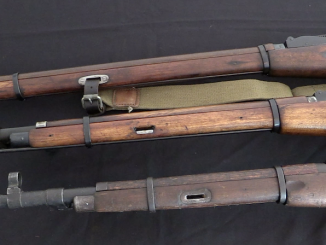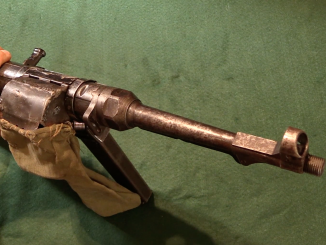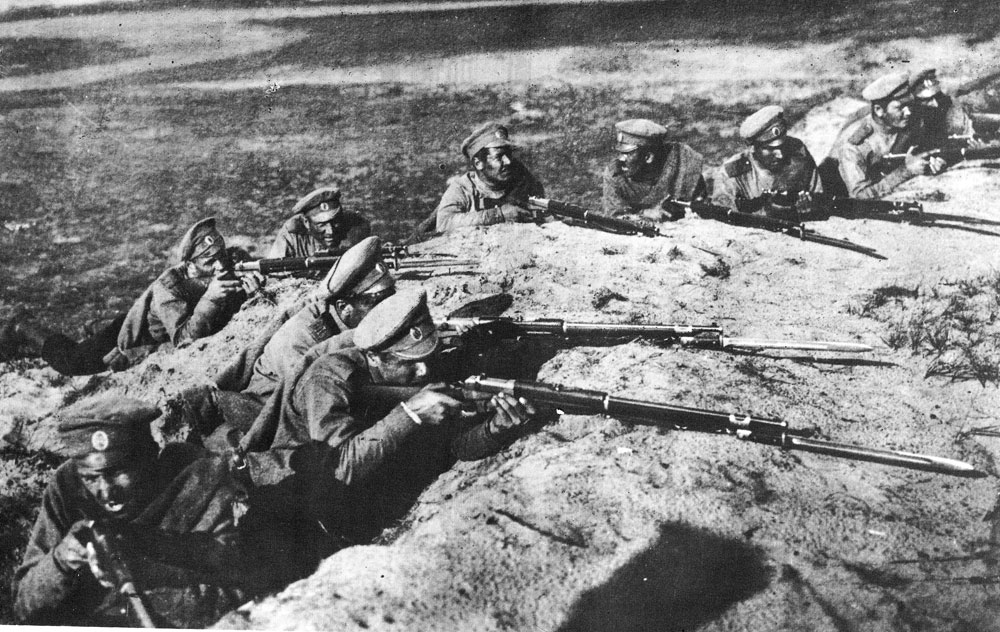Despite having early experience with the Madsen LMG prior to World War One, the Soviet military opted to follow the German path of machine gun development after the war. Valuing the sustained firepower of belt-fed guns like the MG08-15 and MG08-18 over the portability of guns like the BAR or Lewis, the Soviet Union formally adopted the Maxim-Tokarev in 1925. However, Degtyarev developed his own simple, light, bis-fed design anyway, with support of one M.V. Frunze in the military establishment.
The Army ultimately came around to the benefits of a more portable light machine gun, and the Degtyarev was adopted in 1927, with production beginning in 1928 (hence the references to both DP-27 and DP-28 as its name). It would continue to undergo iterative development for several years, eventually becoming a very durable and reliable weapon for the Red Army. Service in World War Two showed a few shortcomings however, resulting in an upgrade program to the DPM, adopted in 1944. This involved moving the recoil spring to the back of the gun, adding a pistol grip, and improving the bipod. In 1946 it was adapted to belt feed, and eventually only pushed out of service by the introduction of the PK in the early 1960s.
Degtyarev’s gas-operated, flapper-locked system proved to be very successful, and he used the same basic system in the DShK, DS-39, and RPD machine guns as well.




Another really good machine gun video. Brings to mind something I have been meaning to ask, have you seen the Col George Chinn collection at the Kentucky Military History Museum? As I recall his focus was on the development of automatic weapons.
It’s interesting that Degtyarev developed the DP-27 with the support of M.V. Frunze, who was also the namesake of the famous Frunze Military Academy, of which he was a one-time commandant. Some of the best officers in the army of the former Soviet Union were the products of the academy, and many fought with great distinction during the Great Patriotic War. As I understand it, the academy was integrated in 1998 with the Malinovsky Military Armoured Forces Academy and the Vystrel Officer Training Courses to create the Combined Arms Academy of the Armed Forces of the Russian Federation.
To fill in on M. Frunze https://en.wikipedia.org/wiki/Mikhail_Frunze
He had rather unusual ethic background. Not a man of “my side” but still, deserves respect for his achievements. When he died he was only 40 years old.
Thanks for the information, Denny. Good to hear from you ( as always )!
Several additions.
The role of Frunze in the creation of the machine gun is a slight exaggeration. The official decision on the need for a light machine gun was made in 1924. This was the work of the commission of Budyonny, the famous commander of the cavalry army. Degtyarev’s work was based on his earlier works together with Fedorov.
Maxim-Tokarev was problematic due to production difficulties. The main competitor of the Degtyarev machine gun was the German Dreise machine gun. The Weimar Republic provided the USSR with several of these machine guns, for the infantry and for armored vehicles.
The main problem with DP was a heavy and not very reliable disk. Back in the 30s, many options were created for tape feed or for the box magazine. But none of them passed the test.
“(…)German Dreise machine gun(…)”
Slight correction: Dreyse which interestingly was name used by firm of Theodor Bergmann
https://www.kalashnikov.ru/po-sheme-drejze/
not the bestlooking around maybe. pan magazin might be kind of.. in the way. but one single question: includind CLEANING the darn thing in the field. whom would opt for the dp compared with a 20rd awkward reload bar? just saying.
“(…)Degtyarev was adopted in 1927, with production beginning in 1928 (hence the references to both DP-27 and DP-28 as its name)(…)”
V. A. Degtyarev in his memoirs titled Моя жизнь states that order for serial production was sent to factories in February 1927. Then he remarks that ДП letters were put at barrels, which stand for Дегтярев пехотный. Note that here first word is in nominativus rather than genitivus.
About the RPD, in Vietnam special forces would take captured RPD guns and cut the barrels just behind the front site to eliminate the weight of the bipod and front site assembly. Made a handy SAW weapon for assaults and ambushes.
Interestingly, guys who trained me commented that in contact, when you heard an RPD, you knew you were in contact with Main Force VC or NVA. That meant trouble. I’ve fired the RPD a lot and it has a very distinctive report. PS: the DP was more popular in Ethiopia and Somalia. Perhaps because you could get the power and range of a 7.62x54R without the weight of a GPMG.
To put it less courteously than Daweo did:
What is the reason for the seemingly American urge to ignore original designations (DP in this case) and invent some out of the blue, American special designation like DP-27 in this case?
From Peter “Paul” Mauser (never, ever saw Paul used by himself or in Germany) to “Schmeißer” for the MP40 (Hugo S. was not involved at all) to the ever-present fabrication AK-47 (show me a single Soviet field manual that uses this designation for the AK or AKM), wrong names are everywhere.
If the Americans prefer their own invented designations to the real ones, that is fine with me.
But the trouble in my view is that many less knowledgeable people look up to American forums, magazines and books as a reliable source. And this creates a sad proliferation of, to put it blunty, fake designations.
The statement by the author of the “Grim Reaper” that he knows AK-47 is totally wrong but he decided to use it, because he thinks his readers cannot handle to be confronted with the correct desigantions [my wording] is in my view one of the lowest points in small arms literature of the last 200 years.
“Schmeisser” is one you can’t blame the U.S. Army for. The British hung that moniker on the Mp38/40 family, because they thought Hugo Schmeisser designed them. As far as is known, the only SMG he ever designed was the original Mp18 Bergmann, which nobody ever referred to as a “Schmeisser”.
In the book Great Weapons of World War Two (Kirk & Young, 1969) there is a photo of a display board in London toward the end of the war with an assortment of German automatic weapons. On it, the Mp40 is still called a “Schmeisser”, and the Mp43 machine carbine is labeled as a simplified version of the “Schmeisser” intended for more rapid production.
Never mind that it’s nearly twice as big, twice as heavy, gas-operated instead of blowback, and fires a totally different and considerably more powerful rifle-type cartridge.
cheers
eon
Eon:
You are right. The British also called all MG34 and MG42s “Spandaus”. But it hardly mattered what the correct title was, only that the troops knew roughly what they were. The misdescription of the MP43 is quite amusing, then again Britain was still using bolt action rifles, they would hardly have had a clue about the birth of the assault rifle.
Meh, the Limeys were also fond of calling pretty much any “machine carbine” a Tommy Gun too… A lot of commercial products get nick-names from one or another designer not associated with the product, or a particular brand name… So Kleenex, Xerox machines, all M1 carbines as “Winchesters” in the Netherlands, all German MGs “Spandaus” after WWI, and much else besides.
There were MP40 magazines marked with Hugo Schmeisser’s patent, even if he had little to no role in the gun itself, so why not a “Schmeßer?” As a person who well remembers the 1980s, every handheld automatic weapon was a danged “Uzi.” That strikes me as a worse case of misnaming things than getting after WWII vets who nick-named the MP40 the “Schmeisser” or the MG42 “Hitler’s buzz-saw” or whatever. In Korea it was “burp gun” for Soviet SMGs…
“(…)British(…)”
In such situation I could only say http://country-balls.com/pineapple/
“(…)photo of a display board in London toward the end of the war(…)nearly twice as big, twice as heavy, gas-operated instead of blowback, and fires a totally different and considerably more powerful rifle-type cartridge(…)”
Was that display available for public? If yes this might be clever deception supposed to work as follows:
1. German superspy use supercamera to take photo of it
2. Deliver said photo to German intelligence
3. Enemy thinks we are dumber that we actually are
Perhaps one could arrive at a plausible explanation were one not so hasty to condemn what one does not understand.
Perhaps, for instance, secretive societies like the USSR made it so hard to know the internal designations that foreigners had no choice but to come up with their own designations. One might also consider how secretive Imperial Japan was to understand why code names were used for various aircraft.
One might also wonder if indeed Americans were the only ones to do this. Complaining about the practice as if it were uniquely American does not make it so.
Felix, I agree with you that intelligence “reporting names” have their purpose. But I do not think they should still be used in professional level publications outside the intelligence community, six decades after the correct designation became known (1960 at the latest).
“(…)Imperial Japan was to understand why code names were used(…)”
This case is different. These names were not corrupted forms of original Japanese and more importantly they conveyed important information for users – female names for bombers (for example NELL for Mitsubishi G3M), male (for example OSCAR for Ki-43) for fighters.
“(…)show me a single Soviet field manual that uses this designation for the AK(…)”
See 8th image from top https://modernfirearms.net/en/assault-rifles/russia-assault-rifles/ak-47-akm-eng/
Daweo, the “Short Manual” (as per title page) for a troop trial with experimental rifle AK-47 does not really qualify as a field manual for the later general issue AK and AKM, which I was referring to.
https://shooter-space.com/media/uploads/2020/06/18/ak.jpg
There was a fair booth.
The machine, which was originally considered the 1947 version, turned out to be completely unsuitable for mass production.
Therefore, a version with a milled receiver was developed.
To avoid confusion (and secrecy), the year was removed from the designation.
Therefore, strictly speaking, the AK47 index should be called that early, stillborn version with a stamped receiver.
But it so happened that under the number AK47 everyone knew the version of 1948, and almost no one knew about the real version of 1947 (until recently) at all.
It is not surprising, it was hardly worth being proud of such a shame. 😉
Here is a couple
http://gasur.ru/build_web/StreamingAssets/chapter_4.html
https://shooter-space.com/blog/kak-pojavilsja-avtomat-kalashnikova
Correction: Never saw “Peter” used by Paul Mauser himself or in German literature.
Sorry.
Sadly, Britannica, which is generally reliable, also further this hoax
https://www.britannica.com/biography/Peter-Paul-Mauser
Didn’t Stephen Hunter say something about this like ‘it was designed by plumbers in a hotel room while they waited for the hookers to show up?’
Close to that, anyhow.
Simple and effective… To get it more simplier, make with one side flapper… IMHO…
I have always thought that this was somewhat of an LMG under rated hero. In many ways a contender to the BREN as the best of this type.
However I lack comparative experience and would welcome a pros and cons or overall assessment of this ‘thought’.